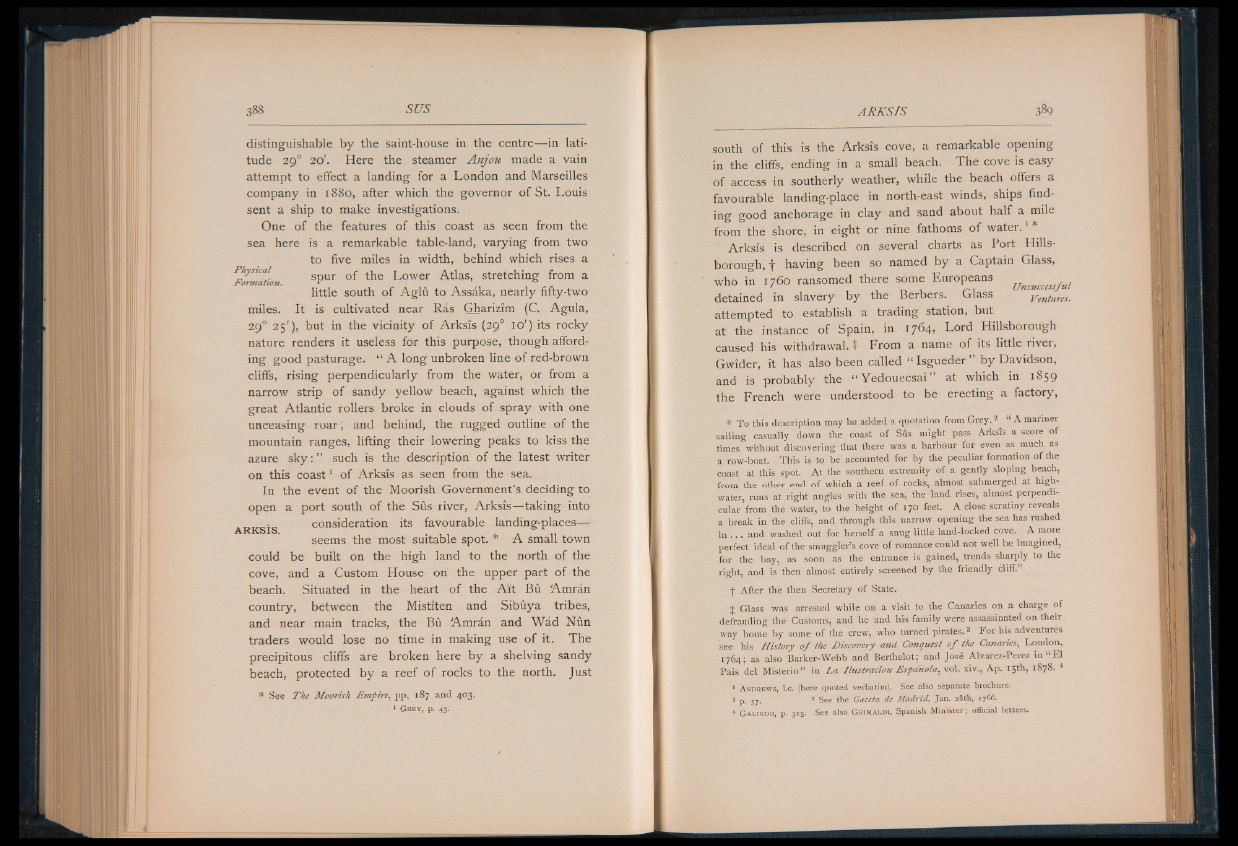
distinguishable by the saint-house in the centre— in latitude
290 20'. Here the steamer Anjou made a vain
attempt to effect a landing for a London and Marseilles
company in 1880, after which the governor of St. Louis
sent a ship to make investigations.
One of the features of this coast as seen from the
sea here is a remarkable table-land, varying from two
to five miles in width, behind which rises a
Physical spur o f the Lower Atlas, stretching from a
formation. r
little south of Aglu to Assaka, nearly fifty-two
miles. It is cultivated near Ras Gharizim (C. Agula,
29° 25'), but in the vicinity of Arksis (290 10') its rocky
nature renders it useless for this purpose, though affording
good pasturage. “ A long unbroken line of red-brown
cliffs, rising perpendicularly from the water, or from a
narrow strip of sandy yellow beach, against which the
great Atlantic rollers broke in clouds of spray with one
unceasing roar; and behind, the rugged outline of the
mountain ranges, lifting their lowering peaks to kiss the
azure s k y : ” such is the description of the latest writer
on this coast1 of Arksis as seen from the sea.
In the event of the Moorish Government’s deciding to
open a port south of the Sus river, Arksis—taking into
- consideration its favourable landing-places— seems the most sui«t1ab1l e spot. 5*lf AA smal11l town
could be built on the high land to the north of the
cove, and a Custom House on the upper part of the
beach. Situated in the heart of the A it Bu Amran
country, between the Mistiten and Sibuya tribes,
and near main tracks, the Bu Amran and Wad Nun
traders would lose no time in making use of it. The
precipitous cliffs are broken here by a shelving sandy
beach, protected by a reef of rocks to the north. Just
* See The Moorish Empire, pp, 187 and 403.
1 G r e y , p. 43.
south of this is the Arksis cove, a remarkable opening
in the cliffs, ending in a small beach. The cove is easy
of access in southerly weather, while the beach offers a
favourable landing-place in north-east winds, ships find-
ing good anchorage in clay and sand about half a mile
from the shore, in eight or nine fathoms of water.1 *
Arksis is described on several charts as Port Hillsborough,
■)■ having been so named by a Captain Glass,
who in 1760 ransomed there some Europeans
detained in slavery by the Berbers. Glass Ventures.
attempted to establish a trading station, but
at the instance of Spain, in 1764» Lord Hillsborough
caused his withdrawal, t From a name of its little river,
Gwider, it has also been called “ Isgueder ” by Davidson,
and is probably the “ Yedouecsai” at which in 1859
the French were understood to be erecting a factory,
* To this description may be added a quotation from Grey.2 “ A manner
sailing casually down the coast of Sirs might pass Arlcsîs a score of
times without discovering that there was a harbour for even as much as
a row-boat. This is to be accounted for by the peculiar formation of the
coast at this spot. At the southern extremity of a gently sloping beach,
from the other end of which a reef of rocks, almost submerged at high-
water, runs at right angles with the sea, the land rises, almost perpendicular
from the water, to the height of 170 feet. A close scrutiny reveals
a break in the cliffs, and through this narrow opening the sea has rushed
in . . . and washed out for herself a snug little land-locked cove. A more
perfect ideal of the smuggler’s cove of romance could not well be imagined,
for the bay, as soon as the entrance is gained, trends sharply to the
right, and is then almost entirely screened by the friendly cliff.”
j- After the then Secretary of State.
t Glass was arrested while on a visit to the Canaries on a charge of
defrauding the Customs, and he and his family were assassinated on their
way home by some of the crew, who turned pirates. 3 For his adventures
see his History o f the Discovery and Conquest o f the Canaries, London,
1764; as also Barker-Webb and Berthelot; and José Alvarez-Perez in “ El
Pais del Misterio” in La Ilustración Española, vol. xiv., Ap. 15th, 1878. 4
1 A n d r e w s , I.e. (here quoted verbatim). See also separate brochure.
2 p< 57> s See the Gaceta de Madrid, Jan. 28th, 1766.
k G a l in d o , p. 315. See also G r im a ld i , Spanish Minister ; official letters.